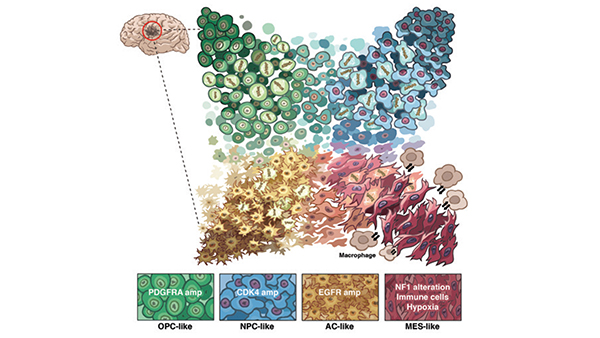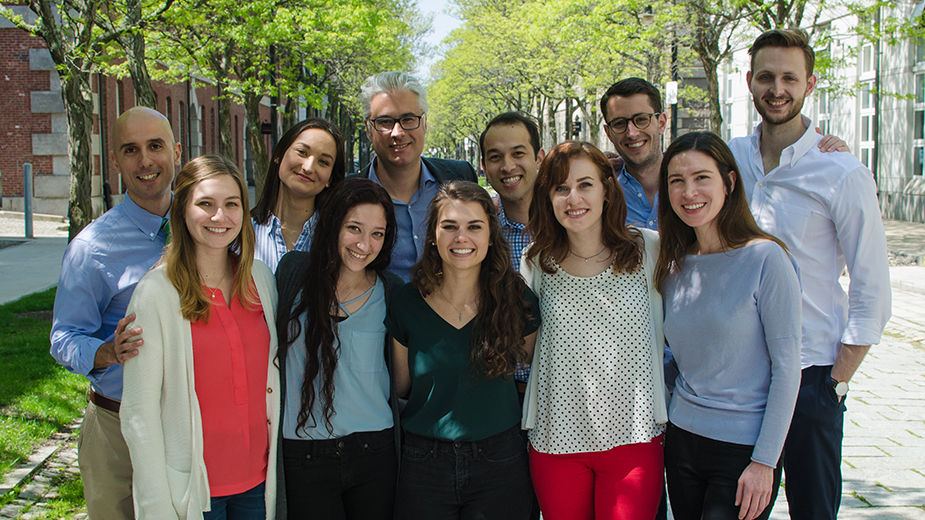Krantz Family Center for Cancer Research
Suvà Lab


Contact Information
Mario Luca Suvà, MD, PhD
Vice-Chair of Pathology for Research
Director, Molecular Pathology Unit
Janet and William Ellery James MGH Research Scholar 2020-2025
Associate Professor of Pathology
Mass General Cancer Center
Program Affiliations
Krantz Family Center for Cancer Research
2024 Krantz Awards Recipient
2024 Breakthrough Award: Using spatial profiling to uncover immunotherapy resistance in brain tumors
Team: Priscilla Brastianos, MD, PhD and Mario L. Suvà, MD, PhD.
Learn about the team's project and the Krantz Awards
Research Summary
The Suvà laboratory develops and applies multi-dimensional spatial genomic, single-cell multi-omic and advanced computational analyses to dissect the biology of adult and pediatric gliomas. We study clinical samples at single-cell resolution and establish genetically and epigenetically faithful cellular models directly from patient tumors. We model how brain cancer cells exploit their plasticity to establish phenotypically distinct populations of cells, with a focus on malignant cell states that we defined. We seek to redefine tumor cell lineages, stem cell programs and immune cells subsets across all subtypes of gliomas, and to leverage the information for renewed therapeutics. The laboratory additionally leverages single-cell and spatial genomics to characterize the cellular and molecular response of brain tumors to experimental therapies.
Research Projects
Cell state heterogeneity is an important disease hallmark of both IDH-mutant glioma and IDH-wildtype glioblastoma, with genetic clonal diversity intermingled with neurodevelopmental trajectories. Stemnessto- differentiation diversity is central to the glioma stem cell (GSC) model, which posits that stem-like cells are uniquely capable of self-renewal, tumor propagation and preferential resistance to therapy. Recent single-cell RNA-sequencing efforts in glioma led by my laboratory provided high-resolution mapping of cell state diversity and offered additional granularity to the GSC model by revealing multiple transcriptionally-defined cell states related to neurodevelopmental cell types. Yet, while cellular states can be precisely delineated by scRNAseq, glioma cell state heritability and transition dynamics are not defined, and the epigenetic underpinning of glioma cellular states is still largely unknown. Equally unaddressed are cellular cross-talks within the glioma ecosystem (e.g. cancer-immune interactions). In order to dissect those influences and obtain a comprehensive view of gliomas biology, my laboratory is leveraging joint capture of transcriptional, genetic, and epigenetic information (DNAme, chromatin accessibility) at the single-cell resolution to primary diffuse gliomas. Additionally, we integrate singlecell genomics of human tumors with mouse models, computational deconvolution of profiles from The Cancer Genome Atlas (TCGA) and functional experiments. Our approach offers a compelling framework to comprehensively dissect the glioma ecosystem, both at diagnosis and under therapeutic pressure.
Assessing malignant cells heterogeneity at the single-cell level in gliomas
The Suvà Lab is performing large-scale single-cell RNA-seq analyses in IDHmutant gliomas, histone H3-mutant midline gliomas, IDH-wildtype glioblastoma, and medulloblastoma to assess tumor cell lineages, stem cell programs and genetic heterogeneity at an unprecedented scale and depth. Our work in IDH-mutant gliomas highlighted a rare subpopulation of actively dividing stem/progenitor cells, solely responsible for fueling tumor growth in patients. Single cell profiling of H3K27- mutant pediatric gliomas highlighted specific vulnerabilities and revealed a differentiation block, maybe explaining the more aggressive nature of this cancer type.
More recently, we provided a comprehensive model of glioblastoma biology that integrates single-cell expression programs, genetic composition and tumor subtypes (see figure). Our study of medulloblastoma single-cell programs provided clarifications on tumor histogenesis and classification. The lab is currently performing such singlecell analyses with constantly increased throughput, resolution and in broader clinical settings (e.g. rare entities, novel clinical trials). Overall, our goal is to identify both lineage-defined and somatically-altered therapeutic targets in brain cancer in both children and adults.
Dissecting the ecosystem of gliomas
The composition of the tumor microenvironment (TME) has an important impact on tumorigenesis and modulation of treatment responses. For example, gliomas contain substantial populations of microglia and macrophages, with putative immunosuppressive functions but whose precise programs remains uncharted at single-cell resolution. In addition, very little is known about the functional state of T cells in human gliomas. As is the case in diverse other conditions, the CNS may create a unique microenvironment that impacts T cell function by distinct mechanisms. The laboratory leverages single-cell analyses in clinical samples to dissect the functional programs of immune cells in gliomas that can be used to elucidate mechanisms relevant to immuno-oncology. We profile both dysfunctional T cells that express multiple inhibitory receptors and T cells that are functional based on expression of multiple genes required for T cell cytotoxicity. We find these modules to be distinct from observations in other types of tumors (such as melanoma), underscoring the necessity to perform these analyses directly in gliomas. By analyzing modules of co-expressed genes in subsets of T cells in patients with glioma we seek to shed light on mechanism of activation and exhaustion in patient tumors and to highlight candidate novel regulatory programs that can be exploited for therapeutics.
Publications
View a list of publications by researchers at the Suva Laboratory
Selected Publications
Greenwald AC†, Galili-Darnell N†, Hoefflin R†, Simkin D, Mount CW, Gonzalez-Castro LN, Harnik Y, Dumont S, Hirsch D, Nomura M, Talpir T, Kedmi M, Goliand I, Medici G, Laffy J, Li B, Mangena V, Keren-Shaul H, Weller M, Addadi Y, Neidert MC, Suvà ML*, Tirosh I*. Integrative spatial analysis reveals a multi-layered organization of glioblastoma. Cell. 2024 April 22.
Spitzer A†, Gritsch S†, Nomura M†, Jucht A, Fortin J, Raviram R, Weisman HR, Gonzalez Castro LN, Druck N, Chanoch R, Lee CK, …, Louis DN, Wakimoto H, Pisano W, Wen PY, Mak TW, Touat M, Landau DA, Ligon KL, Cahill DP*, Suvà ML*, Tirosh I*. Mutant IDH inhibitors induce lineage differentiation in IDH-mutant oligodendroglioma. Cancer Cell. 2024 April 4.
Mathewson ND†, Ashenberg O†, Tirosh I†, Gritsch S†, Perez EM†, Marx S†, Jerby-Arnon L, Chanoch-Myers R, Hara T,…Louis DN, Ligon KL, Marson A, Chiocca EA, Reardon DA, Regev A*, Suvà ML*, Wucherpfennig KW*. Inhibitory CD161 Receptor Identified in Glioma-infiltrating T cells by Single Cell Analysis. Cell. 2021 Mar 4;184(5):1281-1298.
Neftel C†, Laffy J†, Filbin MG†, Hara T†, Shore ME, Rahme GJ, Richman AR, Silverbush D, Shaw ML, Hebert CM, Dewitt J, Gritsch S, Perez L, Gonzalez Castro LN, …, Louis DN, Regev A, Bernstein BE, Tirosh I*, Suvà ML*. An integrative model of cellular states, plasticity and genetics for glioblastoma. Cell. 2019 Aug 8;178(4):835-849.
Filbin MG†, Tirosh I†, Hovestadt V†, Shaw ML, Escalante LE, …, Getz G, Rozenblatt-Rosen O, Wucherpfennig KW, Louis DN, Monje M, Slavc I, Ligon KL, Golub TR, Regev A*, Bernstein BE*, Suvà ML* Developmental and oncogenic programs in H3K27M gliomas dissected by single-cell RNA-seq. Science, 2018 Apr 20;360(6386).
Venteicher AS†, Tirosh I†, Hebert C, Yizhak K, Neftel C, Filbin MG, Hovestadt V, ..., Cahill DP, Rozenblatt-Rosen O, Louis DN, Bernstein BE, Regev A*, Suvà ML*. Decoupling genetics, lineages and micro-environment in IDH-mutant gliomas by single-cell RNA-seq. Science. 2017 Mar 31; 55(6332).
*co-senior authorship
†co-first authorship
Research Image

Model for the cellular states of glioblastoma and their genetic and micro-environmental determinants. Mitotic spindles indicate cycling cells. Lighter/darker tones indicate strength of each program. Intermediate states are shown in between the four states and indicate transitions.
Our Researchers

Suva Lab Members
Mario Luca Suvà, MD, PhD
Principal InvestigatorGroup Members
- Ester Calvo Fernandez, PhD
- Yilin Fan, PhD
- Demi Gerovasilis, BS
- Nick Gonzalez-Castro, MD, PhD
- Alexander Jucht*
- Sophia Kovatsis, BS
- John Lee, PhD
- Vamsi Mangena, PhD
- Chris Mount, MD, PhD
- Florian Ruiz, MD, PhD
- Min Yang, PhD
- Jun Zhong, BS
Krantz Family Center for Cancer Research
The scientific engine for discovery for the Mass General Cancer Center.
Support the Krantz Family Center for Cancer Research
When you support us you are enabling discoveries that will lead to effective new weapons in the battle against cancer.
